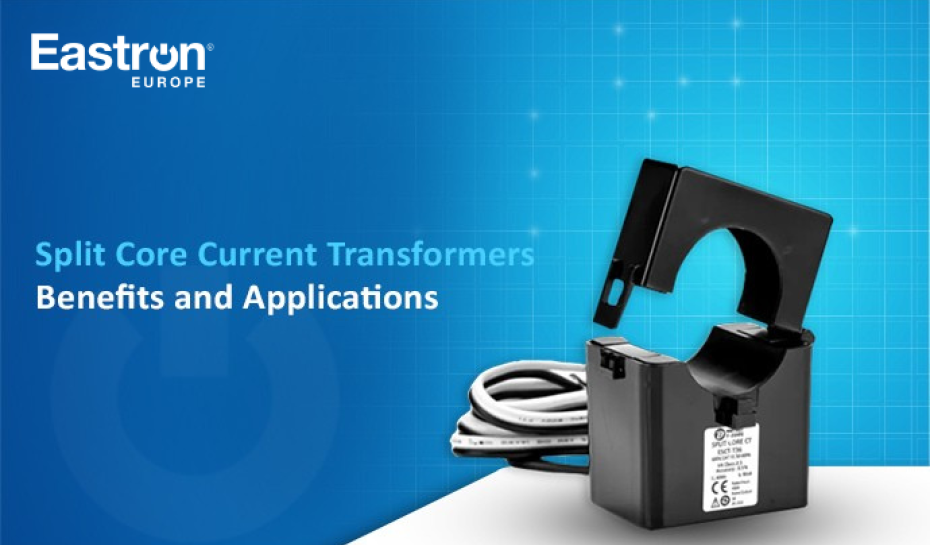
Understanding Split-Core Current Transformers - Benefits and Applications
Accuracy and flexibility are critical in modern electrical measurement and monitoring. The split-core current transformer (CT) is widely used in metering, energy management, and retrofit applications. Designed for efficiency and ease of installation, these CTs allow engineers and facility managers to measure current without interrupting live circuits. This unique feature sets them apart in industrial and commercial settings.
What is a Split-Core Current Transformer – A Brief Overview
A split-core CT is designed with a hinged or detachable core. This allows it to be clipped directly around an existing conductor without disconnecting wiring, making it invaluable in retrofit environments where downtime is not an option.
Key aspects:
- Design: Hinged or separable core for quick installation.
- Operation: Measures alternating current (AC) by transforming high current into a proportional, manageable level for meters.
- Flexibility: Available in different ratings, such as 100A or 200A split-core CTs, to suit varied loads.
How Does a Split-Core CT Work?
Split-core CTs operate on the principle of electromagnetic induction. The transformer’s core senses the magnetic field generated by the conductor and produces a scaled-down secondary current.
Breakdown:
- Primary Conductor: The load cable passes through the CT.
- Magnetic Field: The current induces a magnetic field around the conductor.
- Core and Windings: The split-core closes around the conductor, with secondary windings that generate a reduced current.
- Measurement: The secondary current (e.g., 1A or 5A) is read safely by energy meters.
- Type of Currents: Current transformers are designed to operate primarily with Alternating Currents (AC) only.
- Load Resistance (Burden): Higher burdens can cause measurement errors by distorting the secondary current. This can directly impact the transformer’s accuracy.
Benefits of Split-Core Current Transformers
- No Downtime: They can be installed easily without disconnecting power.
- Ease of Installation: Clip-on design reduces time and labour costs.
- Versatility: Available in various sizes and current ratings.
- Accuracy: Suitable for monitoring and energy management, though usually less precise than solid-core CTs.
- Safety: Enables external monitoring of high currents, reducing risks.
- Compatibility: Works with most energy meters and building management systems.
Common Applications
- Commercial Buildings: Energy monitoring in offices, malls, and data centers.
- Industrial Plants: Retrofitting machinery without halting operations.
- Renewable Energy: Monitoring solar and wind power installations.
- Utilities: Used mainly for temporary monitoring or sub-metering, not revenue-grade billing.
- OEMs and Panel Builders: Integration into advanced electrical panels.
Choosing the Best Split-Core CT
Factors to consider:
- Current Rating: Match to expected load (e.g., 100A or 200A).
- Size & Opening: Ensure aperture fits conductor.
- Accuracy Class: Higher precision is essential for billing-grade metering.
- Burden and Output: Match CT output (e.g., 1A or 5A) and ensure the connected burden does not exceed rated limits.
- Durability: Select robust designs for harsh environments.
- Flexibility: Consider flexible-core CTs for irregular cables or busbars.
Split-Core vs. Other CTs – Key Differences
- Split-Core CTs: Best for retrofits, live installations, and flexible applications.
- Solid-Core CTs: Offer higher accuracy and are preferred for permanent and billing-grade metering but require downtime during installation.
- Flexible CTs (Rogowski Coils): Excellent versatility for large or irregular conductors but less accurate for billing.
Conclusion
The split-core current transformer is a practical solution where convenience and flexibility outweigh maximum accuracy. Its unique design allows quick installation without downtime, while its range of sizes (100A to 200A and beyond) makes it adaptable across industries.
For applications in commercial buildings, renewable energy systems, or industrial plants, split-core CTs empower engineers to monitor and optimize energy usage efficiently. However, for revenue-grade billing, solid-core CTs remain the preferred choice.
